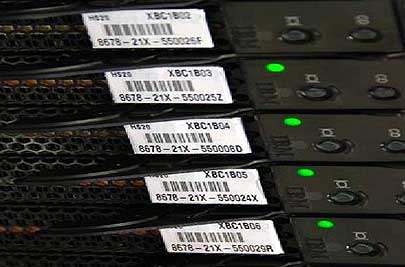May 13, 2008IT giant IBM is launching a packaged RFID solution enabling companies to track valuable IT assets. Four data centers operated by IBM—three in Europe, one in the United States—as well as a data center operated by a major insurance provider located in Germany, are already employing the RFID-based system to improve the speed and accuracy with which they can track valuable, mobile IT assets such as blade servers, laptops and peripherals. Based on the success of those deployments, IBM is now marketing the RFID solution to other companies as well.
The solution, according to Nancy Kingston, a global solutions executive with IBM's Sensor and Actuator Solutions division, was created by an IBM development center in Dublin in response to requests for such an application—both from business groups within IBM, and from the company's customers. Kingston says the system is comprised of hardware, software and installation services.
Prior to being deployed by end users, Kingston says, the application showed promise: An IBM test center in the United Kingdom carried out a time-and-motion study that involved taking inventory of 150 tagged assets manually, then with a bar-code scanner, and finally with an RFID handheld interrogator. The results, she notes, showed that the RFID-based inventory process was six and a half times faster than the bar code-based procedure, and 11 times as fast as the manual method.
But one of the real-world deployments, Kingston adds, has shown even better metrics, with the inventory of tagged IT items completed 15 times faster than it would take to count them manually. "We're seeing really significant results in doing inventory with RFID versus bar code," she says, "in terms of speed and accuracy and overall productivity gains." The solution, for which IBM has partnered with tag maker Omni-ID, is the latest in a series of RFID-based offerings created by IBM—all designed to improve business processes in industries ranging from health care to manufacturing.
Overall, the use of RFID in asset-tracking applications has grown markedly over the past year. Tag makers continue to make strides in developing passive RFID tags that operate well when mounted on or near metal, which tends to interfere with RF signals. This means passive tags are becoming a viable option for IT asset-tracking applications in which tags are mounted on servers, blades, laptops and other IT devices. To date, most IT asset-tracking applications have used active (battery-powered) RFID tags, such as that offered by RF Code (see RF Code Announces Platform for Tracking IT Assets).
IBM provides the data centers with RFID tags pre-encoded with unique serial numbers, after which the centers apply the tags to assets and associate each tag's ID number (also printed on the tag's face, both as text and as a bar code) with the corresponding asset's internal identification numbers. According to Thomas Pavela, president of Omni-ID, his company and IBM are currently developing a means by which end users will be able to encode and print an ID number and bar code of their choosing on a small RFID-enabled label, then attach that label to the base of the plastic housing containing the plasmonic structure layer to form a complete tag. This, Pavela says, will provide customers with the flexibility to encode their internal asset identifiers directly to the tags, rather than associating a pre-encoded tag serial number to their internal numbering system in a database in the Asset Tracking software, which IBM developed as part of the solution.
The software, which runs on IBM WebSphere Premises Server platform, stores the data encoded to each asset tag and maintains a database associating tag data with an asset's location. According to Kingston, the software will associate a single blade's tag data to a server, the server to the data encoded to a tag mounted on a rack holding it, and the location of the rack on a specific floor—and the floor itself—to an entire building.
Customers can choose either handheld interrogators, for reading tags on assets stored in server racks, for instance, or fixed-position readers that can be used to interrogate the tags attached to assets as they are brought into and out of specific choke points. (The assets could be associated with the individuals bringing them through the choke points if workers carry RFID-enabled personnel IDs.)
Kingston says IBM is offering a startup package, starting at just under $100,000, that consists of two handheld Intermec computers with an IP4 RFID interrogator and a bar-code scanner, the IBM Asset Tracking application, running on an IBM X-Series Pentium server with the Microsoft XP operation system, and 5,000 Omni-ID Prox tags. IBM, she says, is seeing strong interest in the solution from clients in the financial services industry.


